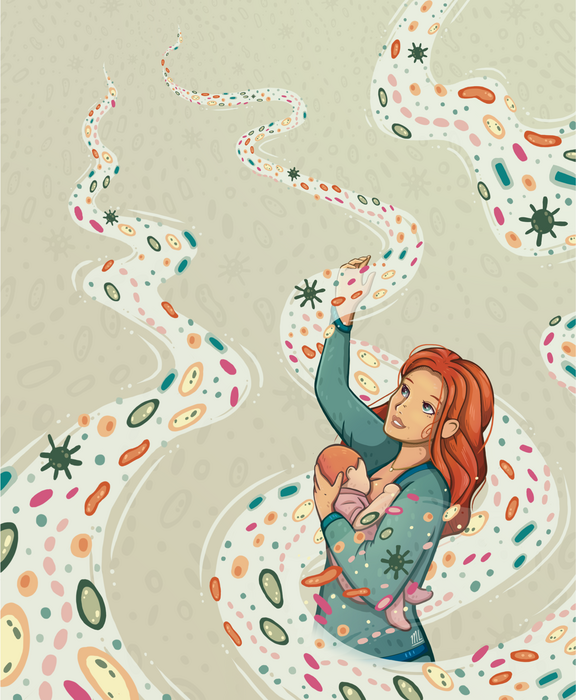Can newborns delivered by cesarean surgery lack vital microbes? Recent data suggests that “no” could be the answer. Mothers are able to transmit bacteria to their babies through alternative, compensating channels, according to research published in the journal Cell Host & Microbe on March 8th, 2023.
 This is an illustration of a mother and infant and the microbes that are transmitted from mother to infant. Image Credit: Mari-Lee Odendaal
This is an illustration of a mother and infant and the microbes that are transmitted from mother to infant. Image Credit: Mari-Lee Odendaal
Although babies delivered via cesarean do not get as much of their mother’s gut microbiome after birth, they make up for it by ingesting their mother’s microbes in breast milk.
The majority of microbiome research has been on the gut, but respiratory tracts, skin, and other regions of human bodies also have healthy microbial communities.
This study sheds light on how the diverse microbes that help compensate a baby’s microbiome, which is generally thought to be sterile before birth, are obtained.
We wanted to have a better idea of how the infant microbiome develops in different parts of their bodies and how it is influenced by factors such as birth mode, antibiotic use, and lack of breastfeeding.”
Wouter de Steenhuijsen Piters, Study Senior Author and Physician and Data Scientist, University Medical Center Utrecht
The team collected samples from 120 Dutch moms and their newborns on a regular basis to better understand how the microbiome changes throughout the first month of life. Two hours after the babies were delivered, and when they were one day, one week, two weeks, and one month old, they took skin, nose, saliva, and gut microbiome samples from the infants.
To identify which of these sources was “seeding” the diverse microbiomes of the babies, the researchers also collected six different types of microbiome samples from the mothers: skin, breastmilk, nasal, throat, fecal, and vaginal samples.
Then, they examined these findings in light of a number of variables, such as delivery method, usage of antibiotics, and breastfeeding, which are considered to affect microbiome transmission.
de Steenhuijsen Piters added, “We saw that many niches of the mother are important for the transmission of microbes, and if some of these pathways are blocked for one reason or another—in this case, we saw that happening with the cesarean section—then these microbes can still reach the infant through other paths.”
The researchers discovered that the mother contributes around 58.5% of a baby’s microbiome, regardless of the baby’s delivery method. Yet, the microbiomes of the infants were affected by different mother microbial communities.
Fewer bacteria were transferred to cesarean-born babies through their mother’s vaginal and fecal microbiomes, but they reportedly obtained more microbes from breastmilk.
Microbiome transfer and development are so important that evolution has ensured that those microbes are transferred one or another way from mother to child. Breastfeeding becomes even more important for children born by cesarean section who do not receive gut and vaginal microbes from their mom.”
Debby Bogaert, Study First Author and Physician Scientist, University of Edinburgh
“It is a smart system, and it makes sense from an evolutionary perspective that these types of pathways are redundant to ensure that the child can begin life with the appropriate ‘starter kit’,” further added de Steenhuijsen Piters.
The team is now interested in learning more about non-maternal factors that affect an infant’s microbiome development.
de Steenhuijsen Piters further stated, “We could see that the maternal microbiome explains almost 60% of the infant’s total microbiome, but there’s still 40% that we don’t know about. It would be interesting to stratify that unknown fraction to see where all the microbes come from; whether fathers contribute, for example, or siblings, or the environment.”
The ultimate goal of the research is to comprehend how infant microbiome development connects to long-term health.
Bogaert stated, “Next, we want to explore whether this early life process, influenced by mom, is affecting not only short-term infection risk in the first year of life but also longer-term health in terms of things like allergies and asthma. In the future, we might be able to utilize this knowledge to help prevent, diagnose, or treat health problems.”
Source:
Journal reference:
Bogaert, D., et al. (2023). Mother-to-infant microbiota transmission and infant microbiota development across multiple body sites. Cell Host & Microbe. doi.org/10.1016/j.chom.2023.01.018